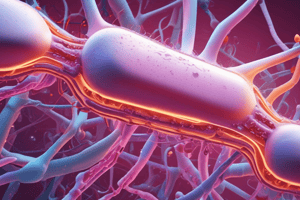Podcast
Questions and Answers
What effect do local anaesthetics have on smaller neurones compared to larger neurones?
What effect do local anaesthetics have on smaller neurones compared to larger neurones?
- They block larger neurones more effectively.
- They have no effect on smaller neurones.
- They affect both types of neurones equally.
- They are more likely to block smaller neurones. (correct)
Which of the following is a common unwanted side effect of local anaesthetics in the cardiovascular system?
Which of the following is a common unwanted side effect of local anaesthetics in the cardiovascular system?
- Sedation.
- Heart block. (correct)
- Increased myocardial contractility.
- Vasoconstriction.
What is the primary purpose of administering vasoconstrictors with local anaesthetics?
What is the primary purpose of administering vasoconstrictors with local anaesthetics?
- To increase the dosage of the anaesthetic.
- To prolong the effect of the anaesthetic. (correct)
- To enhance the permeability of the nerve.
- To decrease pain sensitivity.
What type of anaesthesia generally provides a larger area of anaesthetisation when administered proximally?
What type of anaesthesia generally provides a larger area of anaesthetisation when administered proximally?
Which local anaesthetic is noted for being the most cardiotoxic?
Which local anaesthetic is noted for being the most cardiotoxic?
What is the primary mechanism by which local anaesthetics block nerve transmission?
What is the primary mechanism by which local anaesthetics block nerve transmission?
What structural feature do local anaesthetics contain that contributes to their pharmacological effect?
What structural feature do local anaesthetics contain that contributes to their pharmacological effect?
Why are local anaesthetics less effective in inflamed tissues?
Why are local anaesthetics less effective in inflamed tissues?
Which state of the voltage-gated sodium channel do local anaesthetics preferentially block?
Which state of the voltage-gated sodium channel do local anaesthetics preferentially block?
What pH condition is optimal for the entry of local anaesthetics through the hydrophobic pathway?
What pH condition is optimal for the entry of local anaesthetics through the hydrophobic pathway?
What type of bond do local anaesthetics with shorter half-lives typically contain?
What type of bond do local anaesthetics with shorter half-lives typically contain?
Which term describes the selective affinity of local anaesthetics for frequently opening sodium channels?
Which term describes the selective affinity of local anaesthetics for frequently opening sodium channels?
What type of receptors do local anaesthetics block more effectively compared to other sensory receptors?
What type of receptors do local anaesthetics block more effectively compared to other sensory receptors?
Flashcards
Local anaesthetics & Neuronal Size
Local anaesthetics & Neuronal Size
Local anaesthetics block smaller neurons more readily than larger fibers, as small neurons are more sensitive.
Prolonging Local Anaesthetic Effect
Prolonging Local Anaesthetic Effect
To prolong the effect of local anaesthetics, they may be administered with vasoconstrictors such as adrenaline.
Side Effects of Local Anaesthetics
Side Effects of Local Anaesthetics
Local anaesthetics cause unwanted side effects when they seep into the general circulation, affecting systems such as the CNS and the cardiovascular system.
Spinal Anaesthesia
Spinal Anaesthesia
Signup and view all the flashcards
Epidural Anaesthesia
Epidural Anaesthesia
Signup and view all the flashcards
Local Anaesthetics
Local Anaesthetics
Signup and view all the flashcards
Nociceptors
Nociceptors
Signup and view all the flashcards
Voltage-gated Sodium Channels
Voltage-gated Sodium Channels
Signup and view all the flashcards
Use-dependent Selectivity
Use-dependent Selectivity
Signup and view all the flashcards
Nerve Block
Nerve Block
Signup and view all the flashcards
Structure of Local Anaesthetics
Structure of Local Anaesthetics
Signup and view all the flashcards
Effect of pH on Local Anaesthetics
Effect of pH on Local Anaesthetics
Signup and view all the flashcards
Entry Pathways for Local Anaesthetics
Entry Pathways for Local Anaesthetics
Signup and view all the flashcards
Study Notes
Local Anaesthetics - Mechanism of Action
- Local anaesthetics block voltage-gated sodium channels, preventing action potentials.
- They don't cause loss of consciousness.
- They work by plugging the pores of the sodium channels.
- Anaesthetic molecules can use hydrophilic or hydrophobic pathways to reach the channels.
- Hydrophilic pathway: ionised anaesthetics pass through the open channel.
- Hydrophobic pathway: unionised anaesthetics pass through the axon membrane.
- The ionised form of the anaesthetic has a stronger affinity for the channels.
- The channels are more open/inactive during action potentials, so anaesthetics are more effective at blocking these channels.
Local Anaesthetics - Structure
- General structure: aromatic region and basic amine side chain joined by an ester or amide bond.
- Molecules are weak bases (pKa range 8-9).
- Ionised in acidic environments, forming cations.
- Ester bonds metabolise more quickly, leading to shorter half-lives (short-acting).
- Amide bonds metabolise more slowly, leading to longer half-lives (long-acting).
Local Anaesthetics - Pain Sensation
- Nociceptors detect damaging stimuli (e.g., tissue injury, extreme temperatures).
- They generate action potentials in response to noxious stimuli.
- These potentials are transmitted to the brain, causing the sensation of pain.
Local Anaesthetics - Side Effects
- Side effects are caused by systemic absorption.
- Cardiovascular effects: reduced myocardial contractility, heart block, dysrhythmia, vasodilation.
- Central nervous system effects: depressive at low and very high concentrations, stimulatory at medium concentrations (restlessness, tremors, agitation).
- Risk of death due to respiratory depression at very high concentration.
- Different anaesthetics have different side effect profiles due to structural differences.
Modes of Administration
- Surface anaesthesia: applied to surfaces such as the mouth, nose, airway, cornea, urinary tract, etc.
- Infiltration anaesthesia: injected directly into tissues.
- Nerve block anaesthesia: injected near nerve trunks to block peripheral sensation.
- Regional anaesthesia: used to anaesthetise large areas (e.g., Bier's block).
- Intravenous regional anaesthesia: injected into veins in a region blocked off from main circulation, commonly used for limb surgery (lidcaine, prilocaine).
Types of Anaesthesia
- Spinal anaesthesia: injected into the cerebrospinal fluid, deep to the dura mater, to block spinal cord, usually used in lower body or abdominal surgeries (lidcaine).
- Epidural anaesthesia: injected into the epidural space, outside the dura mater, to block spinal roots, commonly used in childbirth or other surgeries (lidcaine, bupivacaine, ropivacaine).
Studying That Suits You
Use AI to generate personalized quizzes and flashcards to suit your learning preferences.




